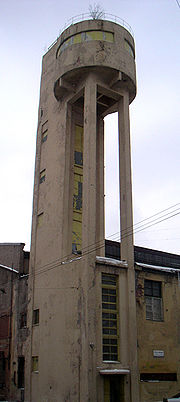
Yakov Chernikhov
Encyclopedia

Pavlohrad
Pavlohrad or Pavlograd is an indistrial city in eastern Ukraine, located within the Dnipropetrovs'ka oblast, and had a population of 118,800 in 2001. The rivers of Vovcha , Hnizdka , Kocherha flow through Pavlohrad. The area of the city is . There are 20 schools and 1 lyceum in the city.In 1930...
, Ukraine
Ukraine
Ukraine is a country in Eastern Europe. It has an area of 603,628 km², making it the second largest contiguous country on the European continent, after Russia...
- 9 May 1951, Moscow
Moscow
Moscow is the capital, the most populous city, and the most populous federal subject of Russia. The city is a major political, economic, cultural, scientific, religious, financial, educational, and transportation centre of Russia and the continent...
) was a constructivist
Constructivist architecture
Constructivist architecture was a form of modern architecture that flourished in the Soviet Union in the 1920s and early 1930s. It combined advanced technology and engineering with an avowedly Communist social purpose. Although it was divided into several competing factions, the movement produced...
architect
Architect
An architect is a person trained in the planning, design and oversight of the construction of buildings. To practice architecture means to offer or render services in connection with the design and construction of a building, or group of buildings and the space within the site surrounding the...
and graphic designer
Graphic designer
A graphic designer is a professional within the graphic design and graphic arts industry who assembles together images, typography or motion graphics to create a piece of design. A graphic designer creates the graphics primarily for published, printed or electronic media, such as brochures and...
. His books on architectural design published in Leningrad between 1927 and 1933 are amongst the most innovatory texts (and illustrations) of their time.
Chernikov was born to a poor family, one of 11 children. After studying at the college of art in Odessa
Odessa
Odessa or Odesa is the administrative center of the Odessa Oblast located in southern Ukraine. The city is a major seaport located on the northwest shore of the Black Sea and the fourth largest city in Ukraine with a population of 1,029,000 .The predecessor of Odessa, a small Tatar settlement,...
, he moved in 1914 to Petrograd (St. Petersburg) and joined the Architecture faculty of the Imperial Academy of Arts
Imperial Academy of Arts
The Russian Academy of Arts, informally known as the St. Petersburg Academy of Arts, was founded in 1757 by Ivan Shuvalov under the name Academy of the Three Noblest Arts. Catherine the Great renamed it the Imperial Academy of Arts and commissioned a new building, completed 25 years later in 1789...
in 1916, where he later studied under Leon Benois
Leon Benois
Leon Benois was a Russian architect. He was the son of architect Nicholas Benois, the brother of artists Alexandre Benois and Albert Benois, and the grandfather of the actor Sir Peter Ustinov...
. Greatly interested in futurist
Russian Futurism
Russian Futurism is the term used to denote a group of Russian poets and artists who adopted the principles of Filippo Marinetti's "Manifesto of Futurism"...
movements, including constructivism
Constructivist architecture
Constructivist architecture was a form of modern architecture that flourished in the Soviet Union in the 1920s and early 1930s. It combined advanced technology and engineering with an avowedly Communist social purpose. Although it was divided into several competing factions, the movement produced...
, and the suprematism
Suprematism
Suprematism was an art movement focused on fundamental geometric forms which formed in Russia in 1915-1916. It was not until later that suprematism received conventional museum preparations...
of Malevich (with whom he was acquainted), he set out his ideas in a series of books in the late 1920s and early 1930s, including:
- The Art of Graphic Representation (1927)
- Fundamentals of Contemporary Architecture (1930)
- The Construction of Architectural and Machine Forms (1931)
- 101 Architectural Fantasies (1933)
The latter, a very fine example of colour printing, was perhaps the last avant-garde art book to be published in Russia during the Stalin
Joseph Stalin
Joseph Vissarionovich Stalin was the Premier of the Soviet Union from 6 May 1941 to 5 March 1953. He was among the Bolshevik revolutionaries who brought about the October Revolution and had held the position of first General Secretary of the Communist Party of the Soviet Union's Central Committee...
ist era. Its remarkable designs uncannily predict the architecture of the later 20th century. However his unusual ideas meant that Chernikhov was distrusted by the regime. Although he continued work as a teacher and held a number of one-man shows, few of his designs were built and very few appear to have survived. Amongst the latter is the tower of the 'Red Nailer' factory in St. Petersburg.
Chernikhov also produced a number of richly designed architectural fantasies of historic architecture, which were never exhibited in his lifetime. A book on 'The Construction of Letter Forms' containing some of his typographical designs, was published after his death, in 1959.
Chernikhov produced some 17,000 drawings and projects and was dubbed the Soviet Piranesi. On August 8, 2006, it was announced that some hundreds of Chernikhov's drawings, with an estimated value of $1,300,000, had gone missing from the Russian State Archives. Some 274 have been recovered, in Russia and abroad.
See also
- Constructivist architectureConstructivist architectureConstructivist architecture was a form of modern architecture that flourished in the Soviet Union in the 1920s and early 1930s. It combined advanced technology and engineering with an avowedly Communist social purpose. Although it was divided into several competing factions, the movement produced...

